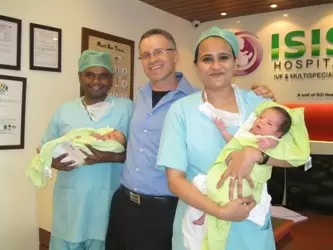The surrogate baby’s right to mothers’ milk need to be recognised, first

09-August-2013
Vol 4 | Issue 32
Childless couples from all over the world bring home babies with help from India’s mushrooming Assisted Reproductive Technology (ART) centres.
But in their haste to hold their babies in their arms, commissioning parents tend to overlook the infant’s need for mother’s milk, despite the fact that it has been scientifically established that mother’s milk is a critical source of nutrition for the infant.
 |
|
Dr Shivani Gour, with a client from Canada. Her South Delhi clinic has conducted 600 surrogate deliveries over the last four years (Photo: SCI Healthcare)
|
It is surprising and disturbing to note that the Government of India’s Health Ministry guidelines on the regulation of ART clinics do not address the issue of breast feeding for surrogate children.
Dr R.S. Sharma, Deputy Director General, Indian Council of Medical Research (ICMR) and Member Secretary of the drafting committee of the Assisted Reproductive Technology (Regulation) Bill agrees that the concern needs to be addressed.
He points out that India's surrogacy industry is presently governed by the Health Ministry approved National Guidelines for Accreditation, Supervision and Regulation of ART clinics, 2005.
“As of now, these guidelines do not address the issue of breastfeeding for children born out of surrogacy but once the ART (Regulation) Bill is passed, the central government will be empowered to frame rules and address the issue of breastfeeding," he observes.
A NOIDA-based couple, who recently brought home a surrogate girl child of 30 days, had the infant breast-fed by the surrogate mother for three weeks. After that they were advised to switch to formula. According to them the child is doing well.
Dr Shivani Gour, whose South Delhi clinic has to its credit 600 surrogate deliveries over the last four years, says, “These children do not get breast milk from the surrogate mother as she is recovering from the pregnancy and does not usually want to breastfeed. Breastfeeding is definitely ideal, but one has to be reasonable.
“Most babies get top feeds but in cases where the biological mother is keen to breastfeed, lactation can be induced. What is required is a long term study, with paediatricians on board, to follow up on the surrogate baby’s health status.”
When her attention was drawn to the fact that the denial of breast milk to a child would constitute a critical nutritional gap, Dr Gour reasoned by saying that there are also cases where biological mothers do not have enough milk and are forced to rely on infant feeding substitutes. “Breastfeeding is desirable but not always possible,” Dr Gour remarks.
Dr Arun Gupta, Coordinator of the Breastfeeding Promotion Network of India and a member of the Prime Minister’s Council on India’s Nutrition Challenges, is not happy with the increasing reliance on infant milk substitutes.
“We are following faulty infant feeding practices. Of the 26 million babies born in India every year, 20 million aren’t able to get optimal feeding. This is part of the same problem – both doctors and the public have lost sight of the value of breastfeeding. They have been led to believe that artificial infant feeding practices are as good as breastfeeding. This is certainly not the case,” he argues.
Dr Gupta recommends the establishment of human milk banks and cites the example of Brazil, which has thousands of such banks where women volunteer milk donations.
Delhi-based clinical nutritionist, Ishi Khosla, agrees, “While surrogacy may be changing the world for many parents, the long term health of the child requires that arrangements be made for breatfeeding. Unless the woman is not lactating, it is not a good enough reason to deny mother’s milk to a child.”
So what are the options available? According to Dr Anuj Gupta, Senior Consultant Pediatrician and neonatologist, NAPI (neonatal and paediatric intensive) Care Group, mother’s milk can either be sourced from milk banks or by inducing lactation in the biological mother. “In India, we have milk banks only in Mumbai and a few other cities, but such facilities are quite common in foreign countries,” he adds.
He also draws attention to a joint statement made in 1980 by World Health Organization (WHO) and United Nations Children's Fund (UNICEF) that clearly states: “Where it is not possible for the biological mother to breast feed, the first alternative, if available, should be the use of human milk from other sources.”
Dr Anuj Gupta adds, “As a paediatrician, I know that breast milk is the best option for the newborn but we have to understand the limitations. If the option of breast milk does not exist, then the other option is to advise formula feed.
“In India, even in the case of babies not born from surrogacy, 20 to 30 per cent could be on formula feeds for various reasons. Breastfeeding may not be a feasible option for every child born out of surrogacy but we encourage commissioning parents to source breast milk from a lactating woman in the family or their social circle after ensuring the serological screening status of the lactating woman.”
According to him, human milk can be stored at minus 20 degrees Celsius for six to 12 months. Feeding of breast milk by a lactating woman not related to the child - traditionally referred termed as a “wet nurse” - has a long history.
Then in the early half of the 20th century, milk banking saw resurgence, but around the 1970s the trend declined because of the fear of the transmission of viruses like HIV, in body fluids, including breastmilk.
Today, with better testing and refrigeration facilities, the milk bank option is growing popular. Behind this intense debate are promising exceptions like Ms TRC (as she chose to be named), a 34-year-old American woman, who has ensured that her son born from surrogacy in India gets exclusive breast milk for a year.
Her first donor was a friend, who introduced her to a social web group where she posted a request for milk donors willing to undergo screening. “The response was overwhelming and I now have enough donors to exclusively breastfeed my son,” she says.
Her planning before the due date of her surrogate baby was meticulous. The donors pumped the milk into sterile bags that contained five ounces of breast milk per bag. To store the milk, a deep freezer was purchased.
Before she came to India, she consulted several sources about the best way to ship breast milk.
“I packed the milk in dry ice and put it in my checked baggage. I coordinated with the hotel and the hospital to make sure they had appliances that could keep the milk at the right temperature for proper storage. The hotel kept the main supply of milk in the restaurant's deep freezer and transferred 10 ounces at a time to the refrigerator,” she recalls.
Once the right of a surrogate baby to mother’s milk is recognised and systems to address the concern are put in place, surrogate parents may not have to go through the expensive and arduous route that commissioning mothers like Ms TRC followed in order to ensure that her child got mother’s milk. - Women's Feature Service















